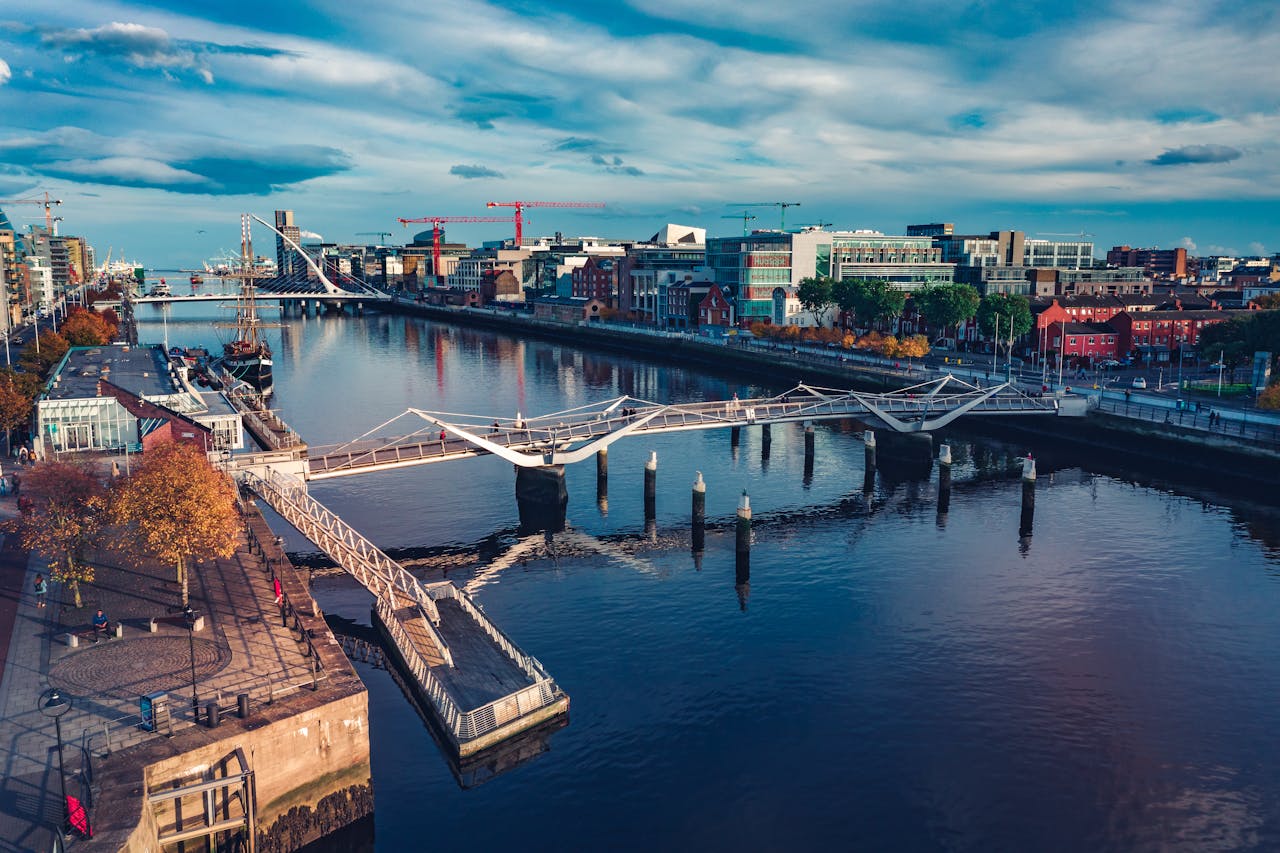Moving to Dublin from the US marks a thrilling chapter in your life. This city mixes historical sights with cutting-edge culture, making it a top choice for many. As you plan your move, knowing the essentials can make all the difference. Dublin greets you with a mix of welcoming neighborhoods and dynamic social scenes. The process involves navigating visas, finding a home, understanding local customs and finding the right moving company. When it comes to finding the right movers, reading Verified Movers reviews is crucial. With practical tips on settling in, from healthcare to social connections, you’re not alone on this journey. Let’s ensure your move to Dublin is as enjoyable as possible, laying the groundwork for an exciting new start in Ireland!
Legal and Paperwork
Diving deeper into the specifics, understanding visa and residency requirements is crucial for those moving to Dublin from US. Ireland offers a range of visa options, including the ‘D’ long-stay visa for those intending to stay longer than 90 days. This category encompasses work, study, and retirement visas, among others. For example, the Critical Skills Employment Permit is designed for highly skilled individuals in areas like IT, engineering, and healthcare, aiming to fill gaps in the Irish labor market. This permit not only facilitates easier access to residency for the holder but also for their immediate family.

Work permits in Ireland generally require a job offer from an Irish employer, who must prove that the position couldn’t be filled by an EU/EEA or Swiss national. The General Employment Permit is a notable option, covering a broad range of occupations and offering flexibility for both employer and employee. So, find a job abroad before making the move!
On the tax front, the US-Ireland Double Taxation Treaty ensures that US citizens moving to Dublin do not pay tax on the same income in both countries. Key provisions allow for the exclusion or credit of certain incomes taxed in Ireland against US tax liabilities. For example, a US expat living in Dublin can utilize the Foreign Earned Income Exclusion to exclude a portion of their income from US taxation, subject to annual adjustments for inflation.
Moving Logistics
Navigating the logistics of moving to Dublin from US requires careful planning, especially when it comes to shipping your belongings. Numerous companies offer international moving services, but prices and delivery times can vary significantly. It’s not the same delivery time for moving from Massachusetts with one of interstate moving companies Massachusetts or from California. It’s crucial to compare quotes and check reviews to choose a reliable shipper that matches your budget and timing needs. When deciding what to bring, consider the climate in Ireland, which is milder but more humid than many parts of the US. This might influence your choice of clothing and electronics. Also, remember that electrical outlets in Ireland use a different standard, so it might be simpler to purchase new appliances upon arrival.
Paring down your possessions can also save on shipping costs. Essentials like important documents, sentimental items, and a few comforts from home should take priority. For furniture and large items, weigh the cost of shipping overseas against the price of buying anew in Dublin. Often, it’s more economical and less hassle to furnish your new home locally.
Once you arrive, setting up utilities in your new Dublin home is straightforward. You’ll need to contact providers for electricity, gas, water, and internet. Ireland has several major providers, and many offer bundled services at competitive rates. Start this process before you move, if possible, to ensure your new home is comfortable from day one. Typically, setting up these services requires proof of address and identification, so keep these documents handy.

Finding a Home
Finding the right home in Dublin requires navigating a competitive housing market. The average house price in the city stands at about €430,000, showcasing Dublin’s position as a sought-after location. On the rental side, the average monthly cost exceeds €2,300, reflecting the high demand for living spaces in Ireland’s capital. This environment calls for a strategic approach to secure a home that meets both your budget and lifestyle needs.
When considering renting versus buying, each option presents its own set of benefits and challenges. Renting offers flexibility and less financial burden in the short term, making it an attractive choice for those new to Dublin or unsure of their long-term plans. It allows you to explore different neighborhoods and understand the city better without the commitment of a mortgage.
On the other hand, buying a property in Dublin is an investment in one of Europe’s most dynamic cities. Despite the higher upfront costs, owning a home can provide stability and the opportunity to build equity over time. However, potential buyers must be prepared for a competitive market, with demand often outstripping supply in popular areas.
Whether you choose to rent or buy when moving from US to Ireland, it’s crucial to start your search early. Utilize online platforms, connect with real estate agents, and network within the community to find the best deals. Being informed about the market trends and knowing what you want will help you make a decision that aligns with your financial situation and lifestyle preferences. Ultimately, securing a home in Dublin opens the door to experiencing life in a lively, culturally rich city.

The best neighborhoods in Dublin
Dublin is a city with a neighborhood for every lifestyle. Whether you’re seeking dynamic nightlife, peaceful green spaces, or family-friendly amenities, Dublin has something special to offer. Here are some of the best neighborhoods in Dublin, each with its own unique charm:
- Ranelagh: Known for its chic cafes and trendy restaurants, Ranelagh is a favorite among young professionals. Its proximity to the city center makes it highly desirable.
- Dalkey: Offering breathtaking views of Dublin Bay, Dalkey is a haven of tranquility. It’s home to celebrities and offers some of the city’s best seafood restaurants.
- Stoneybatter: Once a working-class stronghold, Stoneybatter has transformed into a hipster paradise. Its array of artisan coffee shops, vintage stores, and gastropubs draw a diverse crowd.
- Rathmines: A mix of students, young professionals, and families enjoy Rathmines for its lively atmosphere and excellent amenities. It’s also known for its multicultural dining scene.
- Ballsbridge: One of Dublin’s most affluent areas, Ballsbridge is dotted with embassies, upmarket restaurants, and beautiful Victorian homes. Its serene parks are perfect for leisurely walks.
- Phibsborough: This up-and-coming area is gaining popularity for its unique mix of old-world charm and new, trendy establishments. It’s friendly, diverse, and has a strong sense of community.
Each of these neighborhoods offers a distinct living experience, reflecting the multifaceted nature of Dublin itself. Whether you’re drawn to the historic streets of Dalkey or the bustling cafes of Ranelagh, finding a place to call home in Dublin after moving from Rhode Island with interstate moving companies Rhode Island means enjoying the city’s rich communities.
The Cost of Living: Dublin Vs. US
Comparing the cost of living between Dublin and the US reveals intriguing differences. On average, Ireland is slightly more expensive than the United States by about 1.9%. However, this figure can be misleading without considering specific locations and expenses. For instance, if we look at New Hampshire, living there is significantly more costly than in Dublin, with overall expenses being 44.1% higher.
Diving into specifics, dining out in New Hampshire costs 30.0% more than in Dublin. Groceries also present a stark difference, being 62.7% more expensive in New Hampshire. This indicates that daily living and food expenses can be substantially higher in certain parts of the US compared to Dublin. Transportation costs, however, tell a different story. In New Hampshire, you’d spend 28.9% less on getting around than in Dublin. This suggests that owning a car or using public transport might be more economical in some US states. Childcare is another category where the cost difference is profound, with expenses being three times higher in New Hampshire than in Dublin.
These comparisons highlight that while Ireland, and Dublin specifically, might seem expensive on the surface, certain US locations can significantly surpass Dublin in living costs. Each category, from food to housing, varies greatly, underscoring the importance of considering individual lifestyle needs and spending habits when comparing living costs between Dublin and the US. In case you decide to move, interstate moving companies New Hampshire are at your service!

Settling In After Moving to Dublin From US
Settling into Dublin after long distance moving involves navigating healthcare, banking, and, for families, the education system. Dublin’s healthcare system offers high-quality services, with access available to both public and private healthcare options. Residents typically qualify for public healthcare through the Health Service Executive (HSE), with services either free or available at reduced costs. However, many opt for private healthcare insurance to gain quicker access to specialists and elective procedures.
Opening a bank account in Dublin is straightforward. You’ll need proof of identity, such as a passport, and proof of address in Ireland. Many banks offer services tailored to newcomers, making it easier to manage your finances as you adjust to your new surroundings. Online banking options allow for convenient management of your accounts and bills, aligning with Dublin’s tech-savvy reputation.
For those moving to Dublin from US with children, Dublin’s education system is robust, offering a range of public, private, and international schools. Education is compulsory for children aged 6 to 16, and the school year runs from late August or early September to June. Public schools do not charge tuition for EU citizens, including a wide range of extracurricular activities and programs. Also, Dublin hosts several international schools, offering curricula from around the globe, which can be an excellent option for families planning a shorter stay or seeking continuity in their children’s education.

Life in Dublin
Life in Dublin offers so much in terms of culture, community, and leisure, making it one of Europe’s most livable cities. Dublin’s culture thrives in its literature, music, and art, with countless opportunities to engage with local traditions. From historic literary pubs frequented by famous writers to live music sessions that fill the air with Celtic tunes, the city’s cultural scene is both rich and accessible. Community spirit runs deep, with various festivals and events throughout the year fostering a sense of belonging among locals and newcomers alike.
Getting around Dublin is straightforward, thanks to a comprehensive public transport network. The city’s buses, trams (Luas), and trains (DART) connect all major areas, making commuting and exploring both convenient and efficient. Cycling has also seen a surge in popularity, with numerous bike lanes and rental schemes available.
For entertainment and leisure, Dublin offers endless possibilities. The city provides a culinary scene worth mentioning, ranging from traditional Irish dishes in cozy pubs to international cuisine in stylish restaurants. Parks like Phoenix Park provide a green oasis for relaxation and outdoor activities, while Dublin Zoo is a favorite for families. Art enthusiasts will find a wealth of museums and galleries, and history buffs can explore ancient castles and cathedrals. Nightlife in Dublin caters to all tastes, whether you’re looking for a quiet pint in a historic pub or a night out in one of the city’s bustling clubs.

The Adventure of Moving to Dublin From US Can Start!
Moving to Dublin from the US is an exciting adventure filled with new opportunities. This journey offers a rich history, amazing culture, and a welcoming community. Settling in Dublin means enjoying its lively streets, friendly locals, and both traditional and modern lifestyles. Whether you’re navigating the logistics of moving, finding the perfect neighborhood, or exploring the diverse entertainment options, Dublin has something for everyone. With the right preparation and an open heart, the relocation can be easier than expected. Welcome to Dublin, where every corner tells a story, and a new chapter of your life awaits!




